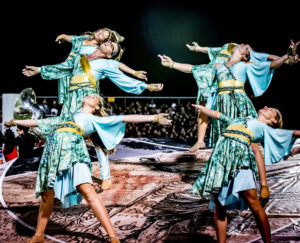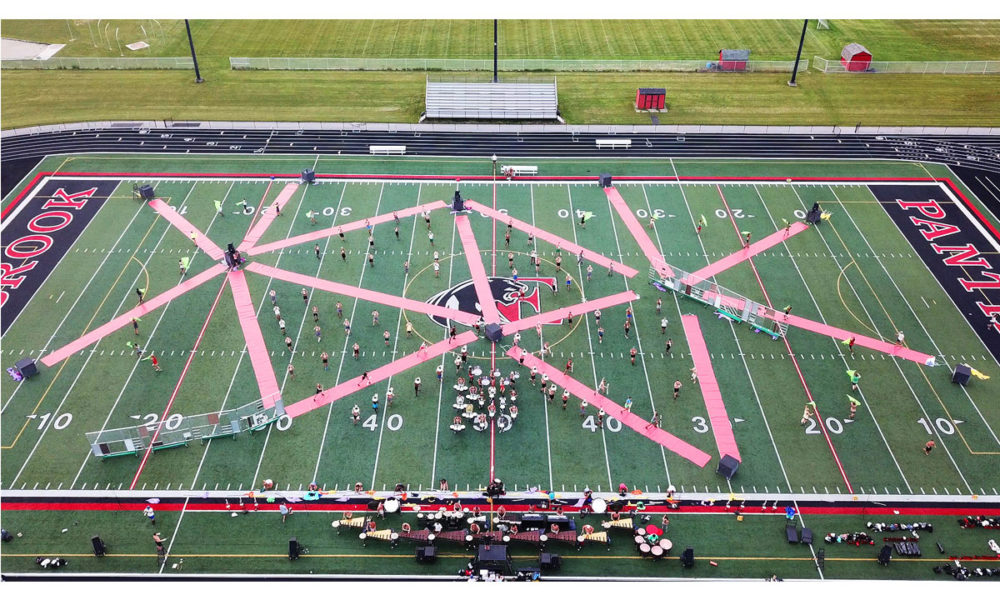Used in various shapes, sizes, and colors, tarps help marching groups transform the football field into their own stage.
Marching bands that use tarps on the football field can transform the setting into a desert outside Area 51, an airplane runway, or even simply a blank, white slate that props and costumes can enhance.
 A few years back, the O’Fallon (Illinois) Township High School Marching Panthers decided to break free from the green turf and rigid yard lines of the field. “The grid does not support the art,” says Dr. Melissa Gustafson-Hinds, director of bands. “It has nothing to do with the message … or emotions that you’re trying to convey to the audience.”
A few years back, the O’Fallon (Illinois) Township High School Marching Panthers decided to break free from the green turf and rigid yard lines of the field. “The grid does not support the art,” says Dr. Melissa Gustafson-Hinds, director of bands. “It has nothing to do with the message … or emotions that you’re trying to convey to the audience.”
Instead, the band unrolled four sections of white tarp that together covered the entire field from sideline to sideline and end zone to end zone for its 2017 show, “The White Canvas,” and its 2018 show, “Stretching the Canvas.”
By using vinyl tarps, which more often employ digital printing to display images and designs, marching arts group are redefining what a show can look like and how it can be framed. During the show, the ensemble gets to be the team that calls the field home.
Field Transformation
Though tarps have traditionally been used by winter guards, drumlines, and winds groups in indoor gymnasiums both for practical and design purposes, tarps on the field are less common. From a practical standpoint, tarps serve to protect the gym floor when used indoors. Outdoor fields don’t need such protection. So what purpose does a tarp serve for the field?
According to marching administrators as well as tarp manufacturers, the function is purely aesthetic. In the same way that concert halls and theaters transform for each production, digitally printed vinyl tarps change a football field designed for a regulated sport into anything that show designers can imagine.
Gustafson-Hinds points out that a white tarp can help any colors pop in the show. On traditional football fields, using the color green in costumes or uniforms is like using “a green screen,” making the performers disappear, she says. A white surface allows green, in particular, to be an option as a color. “You don’t have the look of the football field,” Gustafson-Hinds says. “You have more of a stage.”
The Cavaliers Drum and Bugle Corps’ 2018 production, “On Madness and Creativity,” used 15 strips of tarp to create a large web system that interconnected the prop stations throughout the field. During the performance, the tarps were folded and unfolded to reveal a colorized interpretation of a Rorschach inkblot test.
Tarps can take audiences to a different intended location. The Harrison High School marching band in Kennesaw, Georgia, incorporates tarps for its 2019 show, “Restricted Area 51.” The tarps emulate a desert floor and an airplane runway.
“My goal was to turn the football field into a military base,” says Tommy Allen, program coordinator for Harrison High School Bands as well as visual designer for The Cavaliers Drum and Bugle Corps.
The idea came about long before the viral “Storm Area 51” phenomenon, the timing of which Allen finds to be an amusing coincidence.
Santa Clara Vanguard’s 2019 show, “Vox Eversio,” took audiences underground. “The goal was to change the stage and to create our own world with the intent to remove any thought of a football field or yard lines, so that the audience would be transported into a totally different place for the duration of the program.”
 For Milford (Ohio) High School’s 2019 show, “From Stone,” the tarps help tell the story. Using three different tarps in three areas of the field, the show follows a sculpture in a studio striving to create its own sculpture. The first tarp represents the head of the sculpture and the intellectual process that goes into art. The second tarp shows the hands of the sculpture and the mechanical process while the third tarp shares the heart that goes into art. One of the tarps is set at an angle on a small ramp to improve visibility and add height as guard members perform on top of it.
For Milford (Ohio) High School’s 2019 show, “From Stone,” the tarps help tell the story. Using three different tarps in three areas of the field, the show follows a sculpture in a studio striving to create its own sculpture. The first tarp represents the head of the sculpture and the intellectual process that goes into art. The second tarp shows the hands of the sculpture and the mechanical process while the third tarp shares the heart that goes into art. One of the tarps is set at an angle on a small ramp to improve visibility and add height as guard members perform on top of it.
Perhaps most interestingly, tarps also have the ability to trick the eye. In The Cadets Drum and Bugle Corps’ 2015 show, “The Power of 10,” the group covered every yard number with a tarp that showed the number 10 on it. Because the colors were an exact match to the grass and paint of the field, the tarps looked like part of the field.
For that effect, The Cadets chose to use fabric rather than vinyl tarps. “We’re not afraid to tackle those things that aren’t necessarily strictly vinyl or aren’t necessarily strictly fabric,” says Doug Gardner, director of Field and Floor FX, which created The Cadets’ tarp that year.
A Growing Trend
While use of tarps on the field is not a new phenomenon, their manufacturers have seen an increase in use by drum corps and fall marching bands in recent years. “We sold tarps to more than 50 schools this year,” says Katrina Stokes, associate director of Band Today.
The competitive culture of the marching arts may be a factor. “People opt into what they see being successful from a trend standpoint,” Allen says. “Sometimes props are the trend; sometimes tarps are the trend; sometimes costuming [is] the trend.”
When bands see other highly visible groups be recognized with certain strategies, they may hope to achieve the same level of excellence by emulating those tactics. “It’s just natural that when someone starts [using cool graphics], and it’s working, and it adds a lot of life to the show, other people do it too,” says Kelley Kramer-Mardis, vice president at Kramer Graphics.
Accessibility is also another key factor. Digital technology has advanced the printing process with a speed that allows the manufacture of custom tarps to be much more affordable without sacrificing quality. This availability leads to more groups using tarps, which, in turn, increases visibility to other groups that have not used tarps before, according to Allen.
Challenges and Solutions
However, using vinyl tarps on top of the field presents some challenges before, during, and after the performances.
Even with practice and preparation, mishaps can happen during the show, as Allen admits. “Tripping over tarps in performances is always an issue,” he says.
To avoid tripping hazards, Allen suggests teaching performers to troubleshoot and fix problems on their own. That way, more common issues can be dealt with in the moment.
The environment can also pose issues. The wind could make using a tarp more difficult. Weighing down the tarp is a solution. Gardner suggests taping chain to the back of the tarp or putting weighted discs in pockets on the back of the tarp. He adds that Field and Floor FX can provide additional matching vinyl or fabric to wrap around bricks to put on top of the tarp.
Finally, bands need to consider the time and resources required for rolling out the tarps and packing them back up during setup and teardown.
O’Fallon had four crews of parents who efficiently learned how to unroll 4,000 pounds of tarp material in less than 90 seconds. Though manpower played a role in O’Fallon’s decision to forego the tarp for 2019, Gustafson-Hinds says that design factors became predominant. “We didn’t want to get pigeonholed into having the same look,” she says. “We just didn’t want to overstay the welcome of it.”
O’Fallon sold its tarp off to other schools in pieces; when the schools came to pick them up, representatives of O’Fallon Township’s band helped load the tarp for transportation and also gave each school tips on how to use and maintain the tarp.
For groups that want to try tarps for the first time, Gustafson-Hinds offers herself as a resource. O’Fallon Township is willing to advise, and already has been advising, schools in this capacity. She offers two simple pieces of advice: “Number 1: Give me a call; I’d love to help with that,” she says. “Number two: Figure out what you want to do.”
In general, Allen does not view any of the obstacles of using tarps as major deal breakers. “For the most part, if you’re able to manage it, and you’re smart about it, [a tarp] seems to bring enough value to the production that it’s still worth those extra things.”
If you decide tarps is the right choice for your group, you might want to check out this article about this equipment cart to help move the tarps around more easily.


